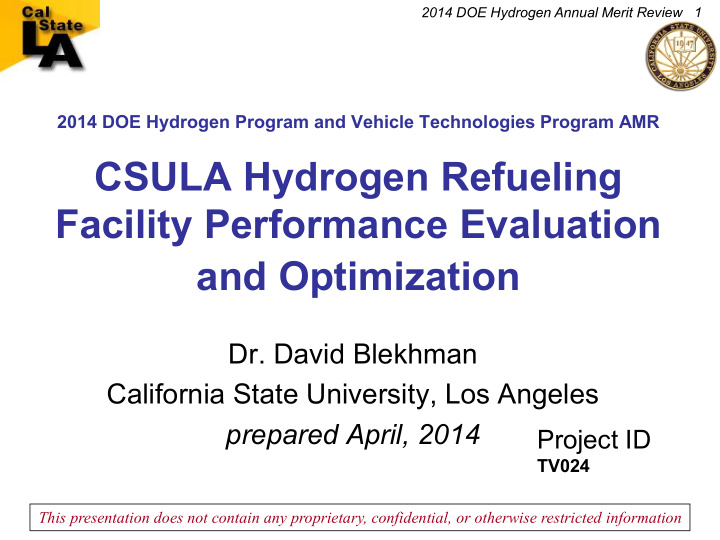



2014 DOE Hydrogen Annual Merit Review 1 2014 DOE Hydrogen Program and Vehicle Technologies Program AMR CSULA Hydrogen Refueling Facility Performance Evaluation and Optimization Dr. David Blekhman California State University, Los Angeles prepared April, 2014 Project ID TV024 This presentation does not contain any proprietary, confidential, or otherwise restricted information
2014 DOE Hydrogen Annual Merit Review 2 Overview Barriers Timeline • Start: 10/01/2012 • End: 09/30/2016 Hydrogen Production and Delivery 50% complete – Reduce the cost of compression, storage, and dispensing at refueling stations Budget – Research and develop low-cost, highly • Expenditure of Government efficient hydrogen production technologies Funds Technology Validation – FY13 $90,000 – Validate complete systems of integrated hydrogen and fuel cell technologies for – FY14 $100,000 transportation, infrastructure and electricity • Total project funding generation applications under real-world operating conditions. – DOE $400,000 Education $400,000 – Contractor – Educate key audiences to facilitate near- term demonstration, commercialization, Partners and long-term market acceptance. • California State University, Los Angeles— Project lead • Hydrogenics Corp.
2014 DOE Hydrogen Annual Merit Review 3 Project Objectives • The project objective is to test, collect data, and validate hydrogen refueling architecture deployed at CSULA and its individual components in a real-world operating environment. The performance evaluations data will be provided to the Hydrogen Secure Data Center (HSDC) at NREL. • Academic objectives – Contribute to the development of new industry standards – Develop and implement fueling station system performance optimization – Conduct outreach and training activities promoting the project and hydrogen and fuel cell technologies – Provide a living-lab environment for engineering and technology students pursuing interests in hydrogen and fuel cell technologies
2014 DOE Hydrogen Annual Merit Review 4 Tasks: Phase 1 Task 1. Develop data acquisition (DAQ) for station performance with existing capability Task 2. Design and implement enhanced data acquisition (DAQ) for station performance evaluation Task 3. Enable hydrogen purity testing and reporting Task 4. Regular data collection and reporting after completing Task 2
2014 DOE Hydrogen Annual Merit Review 5 Tasks: Phases 2 and 3 Task 4. Regular data collection and reporting after completing Task 2 Task 5. Conduct outreach and training activities for public and government and engage students in station related activities. Task 6. Data reporting update and station performance optimization after completing Task 4 Task 7. Evaluate station utilization and assess the need for station upgrades and enhanced performance
2014 DOE Hydrogen Annual Merit Review 6 Hydrogen Fueling and Research Facility
2014 DOE Hydrogen Annual Merit Review 7 CSULA Hydrogen Station Specs Production: 60 kg/day Storage: 60 kg Pressure: 5,000 and 10,000 psi Capacity: 15-20 fuel cell vehicles per day
2014 DOE Hydrogen Annual Merit Review 8 Approach/Strategy: Facility Power Meters Electrolyzer Compressor 1 Compressor 2 Compressor 3 Chiller Process chiller Air compressor Dispenser Facility Master Meter: Base load (above) Electrolyzer on (right) Facility Power Meters Junction Box
2014 DOE Hydrogen Annual Merit Review 9 Accomplishments: Readings in the Interface
2014 DOE Hydrogen Annual Merit Review 10 Accomplishments: Reports Automatically Generated Data is collected in Microsoft SQL database Upon request performance reports are automatically generated
2014 DOE Hydrogen Annual Merit Review 11 Performance Upgrades Up to 10 MPa pulsations are observed during fueling (top right) 90 80 80 Pulsation-free fueling 60 70 (bottom right) Pressure, MPa 60 40 Temp, degC 70 MPa Hose Pressure 50 20 4 x 50L 70MPa buffer tanks 40 Vehicle Pressure, MPa 30 0 70 MPa Hose Temp (below) 20 Vehicle Temp -20 10 0 -40 150 250 350 450 550 650 time, s 90 80 80 60 70 Pressure, MPa 60 40 Temp, degC 50 70 MPa Hose Pressure 20 40 Vehicle Pressure, MPa 30 0 70 MPa Hose Temp 20 Vehicle Temp -20 10 0 -40 150 250 350 450 550 650 time, s
2014 DOE Hydrogen Annual Merit Review 12 Hydrogen Purity Testing • MRI: Acquisition of a Multifunctional Hydrogen Gas Analyzer for the Center for Energy and Sustainability – NSF, $512,000
2014 DOE Hydrogen Annual Merit Review 13 Collaborations: Dispensing Meter Testing 2.505 kg 1.101 kg 1.405 kg
2014 DOE Hydrogen Annual Merit Review 14 Outreach International visitors First responder training Scholars, students Professional meetings Local government
2014 DOE Hydrogen Annual Merit Review 15 Future Work: Research Opportunities • Performance Optimization, Hydrogen Fleet and Infrastructure Analysis – Weekly patterns/storage – Availability via mobile app – Metering • Smart Grid: Load Following with Renewable Power Generation – Off-peak load Intermittent wind exceeds load – Load shedding • Workforce, Public and Professional Education
2014 DOE Hydrogen Annual Merit Review 16 Summary • RELEVANCE. Program demonstrates high relevance to the DOE Hydrogen and Fuel Cell program especially in light of rapid development of hydrogen infrastructure in CA and thousands of FCV expected in 2015. • APPROACH. Reviewed NREL reporting requirements and identified instrumentation needed. Developed pathways to improve station performance. • ACCOMPLISHMENTS. Tasks 1 and 2 completed. Transitioning into 3, 4 and 5. Implemented installation of power and flow meters. Installed buffer tanks. Created Microsoft SQL database, ability to generate quarterly reports and perform individual equipment performance assessment. • COLLABORATIONS and OUTREACH. Rapid development of collaborations: CA DMS, CAFCP, H2FIRST. Funded member of the Southern CA Alternative Fuel Center. Conducted robust outreach activities. • FUTURE WORK. Short term: collecting data, analyzing station and individual equipment performance. Long term: smart grid, infrastructure and expanded education opportunities.
Recommend
More recommend